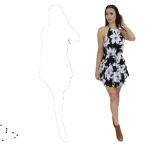A drop shadow service typically refers to a graphic design or image editing technique where a shadow is added to an object to create the illusion of it being lifted off the background. This shadow, known as a drop shadow, provides depth and makes the object appear as if it is casting a shadow on a surface. In this article, we talked about why you need drop shadow service for Ecommerce success.
Drop shadows are commonly used in various design projects, including web design, advertisements, and presentations, to add a three-dimensional feel and make objects stand out from the background.
In the context of graphic design software or image editing tools, some features or services allow users to easily apply drop shadows to elements like text, images, or shapes. Users can customize parameters such as the shadow’s opacity, angle, distance, and blur to achieve the desired visual effect.
Why You Need Drop Shadow Service for Ecommerce Success?
Drop shadow services play a significant role in optimizing the visual appeal, professionalism, and overall presentation of products on e-commerce websites. This, in turn, contributes to a positive user experience, helps build trust, and can lead to increased sales and business success
Drop shadow services are often used in e-commerce for several reasons that contribute to the overall success of online businesses:
Product Highlighting:
Drop shadows can be applied to product images to create a sense of depth and make the products appear more realistic. This helps in highlighting the main features of the products, making them more appealing to potential buyers.
Visual Consistency:
Consistent and professional-looking product images across an e-commerce website contribute to a positive user experience. Drop shadows can be applied uniformly to maintain a cohesive and polished look throughout the product catalog.
Enhanced Visibility:
The use of drop shadows can improve the visibility of products by making them stand out from the background. This is particularly important for e-commerce platforms where products need to capture the attention of shoppers quickly.
Contextual Realism:
Drop shadows can create a sense of realism by simulating how products might appear in a real-world setting with natural lighting conditions. This can help customers visualize the product more accurately before making a purchase.
Professional Aesthetics:
A well-designed and visually appealing website is more likely to instill trust in customers. Drop shadows, when applied skillfully, contribute to the overall professionalism and aesthetics of the product images, positively impacting the perception of the brand.
Brand Image:
Consistent use of drop shadows in product images can become a part of the brand’s visual identity. This helps in establishing a recognizable and memorable brand image, which is crucial for long-term success in e-commerce.
Increased Conversions:
High-quality, visually appealing product images can lead to increased customer engagement and, ultimately, higher conversion rates. When customers can see and understand the products they are interested in, they are more likely to make a purchase.
Also Read
Future Trends of Drop Shadows
Predicting specific future trends in design, including the use of drop shadows, can be challenging, as design preferences often evolve based on various factors, including technology, cultural shifts, and aesthetic movements. However, I can provide some general insights into potential directions for the use of drop shadows in the future:
Subtle and Realistic Shadows:
As design tools and techniques become more advanced, there may be a trend toward more subtle and realistic drop shadows. Designers might experiment with creating shadows that closely mimic natural lighting conditions, contributing to a more authentic and immersive visual experience.
Interactive and Dynamic Shadows:
With advancements in web technologies, interactive and dynamic design elements are becoming more prevalent. Future trends might involve drop shadows that respond to user interactions or changes in the user interface, providing a dynamic and engaging visual experience.
Adaptive Design Shadows:
As the importance of responsive and adaptive design continues to grow, drop shadows might be tailored to different screen sizes and devices. Designers may focus on creating shadows that enhance readability and usability across a range of platforms.
Innovative Use in Augmented Reality (AR) and Virtual Reality (VR):
As AR and VR technologies become more integrated into design processes, drop shadows could play a role in creating depth and realism within virtual environments. This might involve experimenting with three-dimensional shadows in virtual spaces.
Minimalist Approaches:
While drop shadows have traditionally been used to create depth, future trends might see designers adopting more minimalist approaches, using subtle shadows or none at all. This could be influenced by design movements emphasizing simplicity and clarity.
Artistic and Abstract Shadows:
Designers might explore more artistic and abstract applications of drop shadows to create unique and visually striking effects. This could involve experimenting with unconventional shapes, patterns, or colors for shadows.
Customization and Personalization:
With the growing emphasis on personalization in design, there may be a trend toward allowing users to customize the appearance of drop shadows. This could include adjusting shadow intensity, color, or direction based on individual user preferences.
It’s important to note that design trends are subjective and can vary across industries and individual preferences. As technology continues to advance and design tools evolve, designers will likely explore new creative possibilities for incorporating drop shadows and other design elements into their work.
How to Calculate Drop Shadow Cost
Calculating the cost of drop shadow services can depend on several factors, and the pricing structure may vary among different service providers. Here are some common considerations when determining the cost of drop shadow services:
Complexity of the Image:
Simple images with straightforward shapes and structures may be less time-consuming to work on, and the cost may be lower.
Complex images with intricate details, irregular shapes, or multiple objects may require more effort and skill, leading to a higher cost.
Quantity of Images:
Many service providers offer bulk pricing or discounts for a larger number of images. The more images you need to process, the lower the cost per image might be.
Turnaround Time:
Urgent or expedited services may incur higher costs. If you have a tight deadline for the completion of drop shadow services, it’s common for service providers to charge a premium for faster turnaround times.
Service Provider’s Expertise:
The skill level and expertise of the service provider can impact the cost. Highly experienced designers or specialized agencies may charge higher rates for their services.
Additional Editing Requirements:
If you have specific requirements beyond basic drop shadows, such as color correction, background removal, or other image enhancements, these additional services can contribute to the overall cost.
Software and Technology Used:
The tools and software used for drop shadow services may vary, and some advanced software solutions may come with higher licensing costs. This could influence the pricing structure.
Geographical Location:
The location of the service provider can also play a role in pricing. Service providers in regions with a higher cost of living may charge more for their services.
Quality and Resolution:
Higher quality and resolution images may require more detailed work, affecting the overall cost. Images with higher resolution or those intended for large-scale printing may involve more intricate shadow rendering.
To calculate the drop shadow cost, you would typically need to consider these factors and obtain quotes from different service providers. Some providers may offer a per-image pricing model, while others may provide a package deal based on the overall scope of your project.
It’s recommended to communicate your specific requirements, such as the number of images, complexity, and desired turnaround time, to get accurate quotes from potential service providers. Additionally, ask about any hidden fees or additional charges that may apply to ensure transparency in the pricing structure.
Also Read
Tips to Choose The Right Drop Shadow Service Provider for Ecommerce Success
Choosing the right drop shadow service provider for your e-commerce business is crucial to ensuring high-quality visuals and a smooth collaboration. Here are some tips to help you select the right service provider:
Portfolio Review:
Examine the provider’s portfolio to assess the quality of their work. Look for examples of drop shadows on various types of products and images. A diverse and well-executed portfolio is a positive sign.
Experience and Expertise:
Check the provider’s experience in offering drop shadow services specifically for e-commerce. An experienced provider is likely to understand the unique requirements of e-commerce product images.
Client Testimonials:
Read client testimonials or reviews to gauge the satisfaction of previous clients. Positive feedback and testimonials can provide insights into the provider’s reliability, professionalism, and the quality of their services.
Turnaround Time:
Consider the provider’s turnaround time for completing projects. If you have tight deadlines for product launches or updates, choose a service provider who can deliver within your required timeframe without compromising quality.
Communication and Collaboration:
Effective communication is essential. Ensure that the provider is responsive to inquiries, understands your specific requirements, and is open to feedback and revisions. A good working relationship is crucial for successful collaboration.
Customization and Flexibility:
Assess the provider’s flexibility in meeting your specific needs. Some projects may require unique approaches, so choose a service provider who is willing to customize their services according to your preferences.
Quality Control Measures:
Inquire about the quality control processes the provider employs. This includes ensuring accurate shadow placement, consistency across images, and attention to detail. Quality control is vital for maintaining a professional and polished look across your product catalog.
Security and Confidentiality:
If your product images contain sensitive information, inquire about the provider’s security measures and their commitment to confidentiality. Ensure that they have protocols in place to protect your images and data.
Cost Transparency:
Clearly understand the provider’s pricing structure. Ask about any additional fees or hidden costs. Compare the pricing with the quality of service to determine the overall value.
Trial or Sample Work:
Some service providers may offer a trial or a sample of their work. Take advantage of this to evaluate their capabilities and assess whether their style aligns with your brand’s aesthetic.
Scalability:
If your e-commerce business is likely to scale up, choose a service provider with the capacity to handle a growing volume of images. This ensures a long-term partnership without the need to switch providers as your business expands.
End Words
By carefully considering these factors, you can identify a drop shadow service provider that aligns with your e-commerce goals and contributes to the overall success of your business







